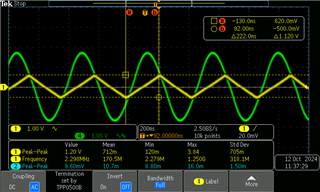Other Parts Discussed in Thread: TLV365
Tool/software:
I’m using OPA323IDCKR as a voltage follower, powered by +/- 2.5V, input is sine wave of 2.3MHz 3.5V pk-pk, output is totally unloaded (only with 10x oscilloscope probe). As you can see, the output is slew rate limited at around 5V/µs, far less than specified.
Any ideas? This is not a special case, it happens in every case. I’m sure that power is applied and decoupled properly. When frequency drops, output turs back to normal.

Green: input, Yellow, output.

